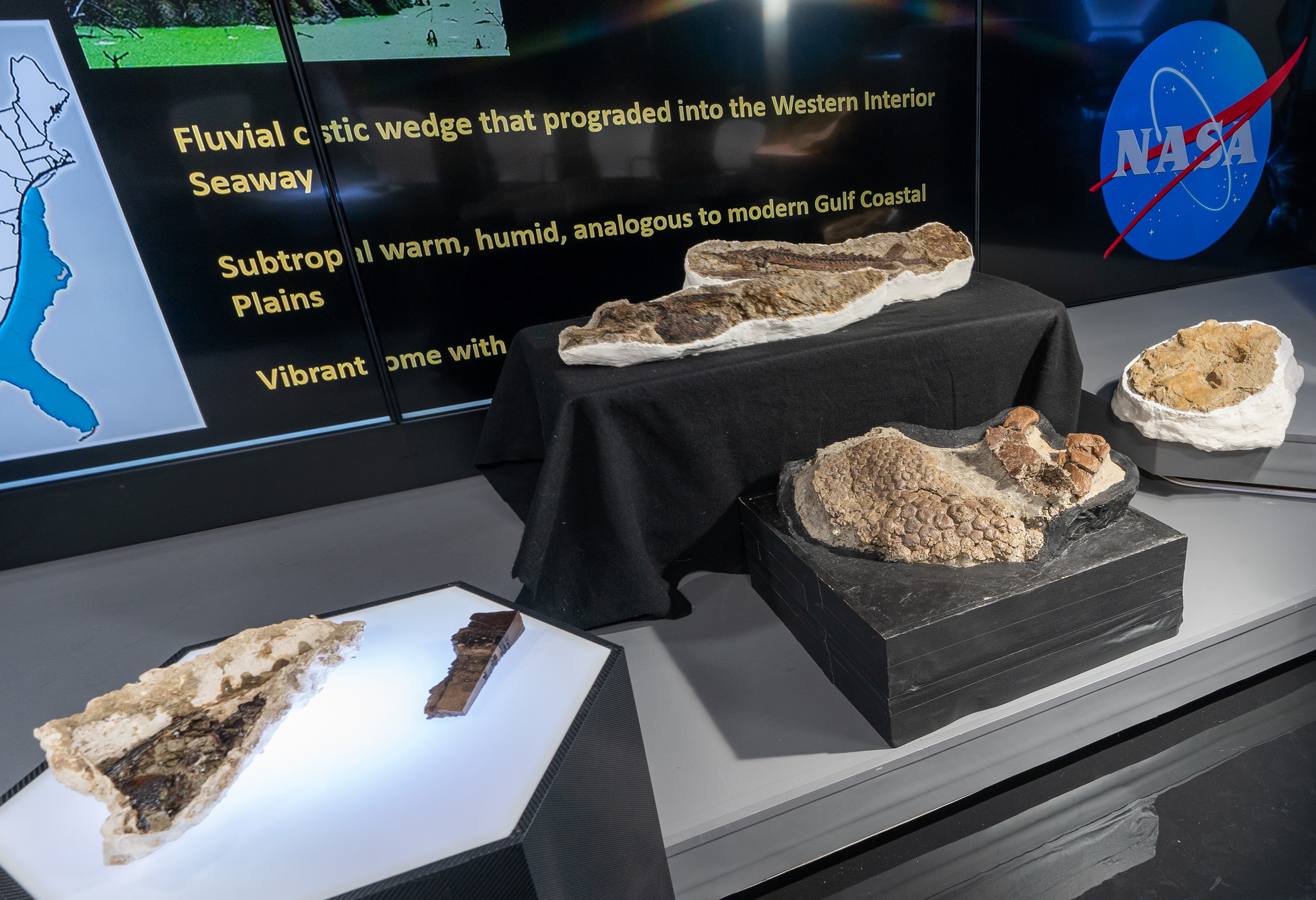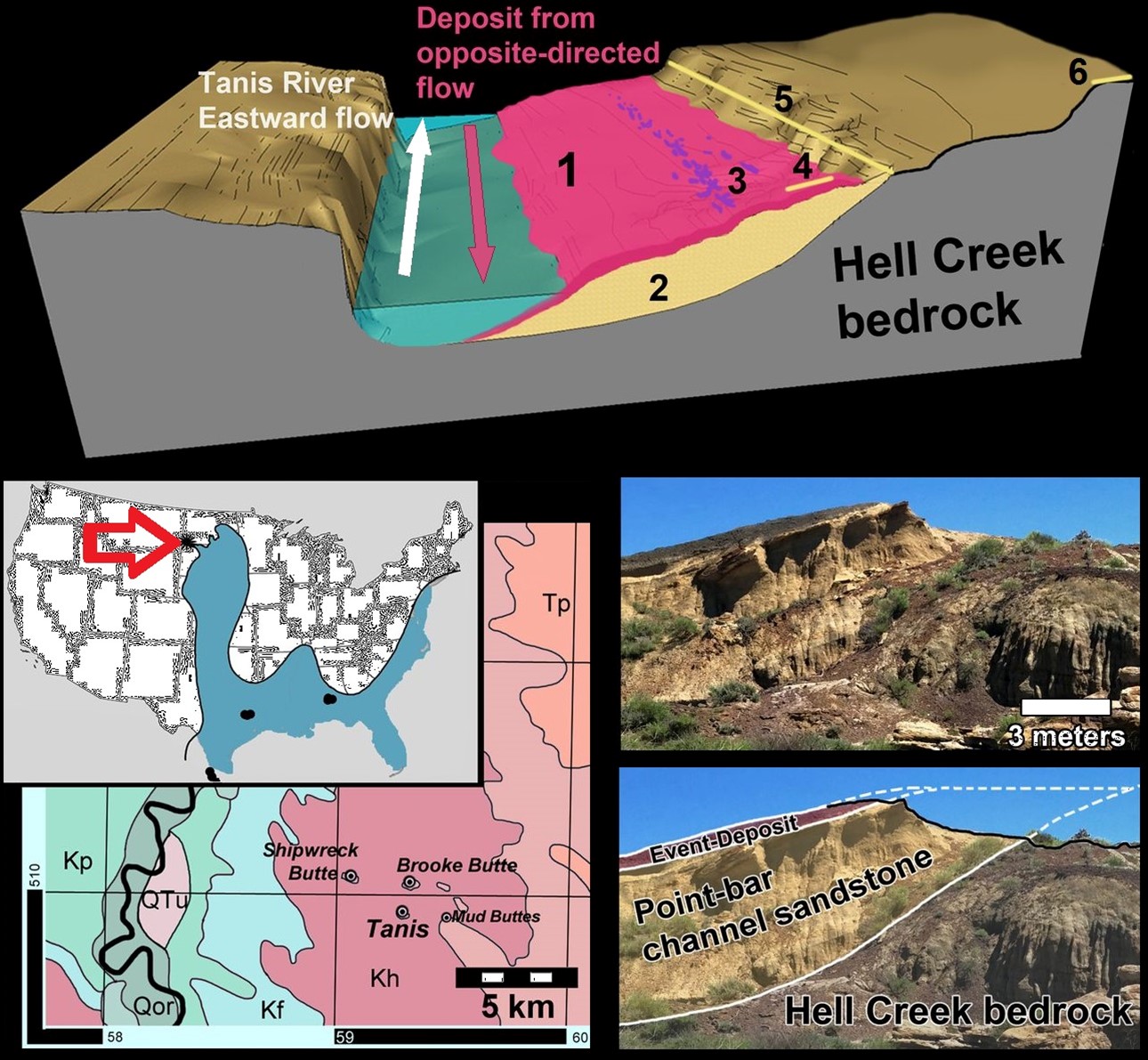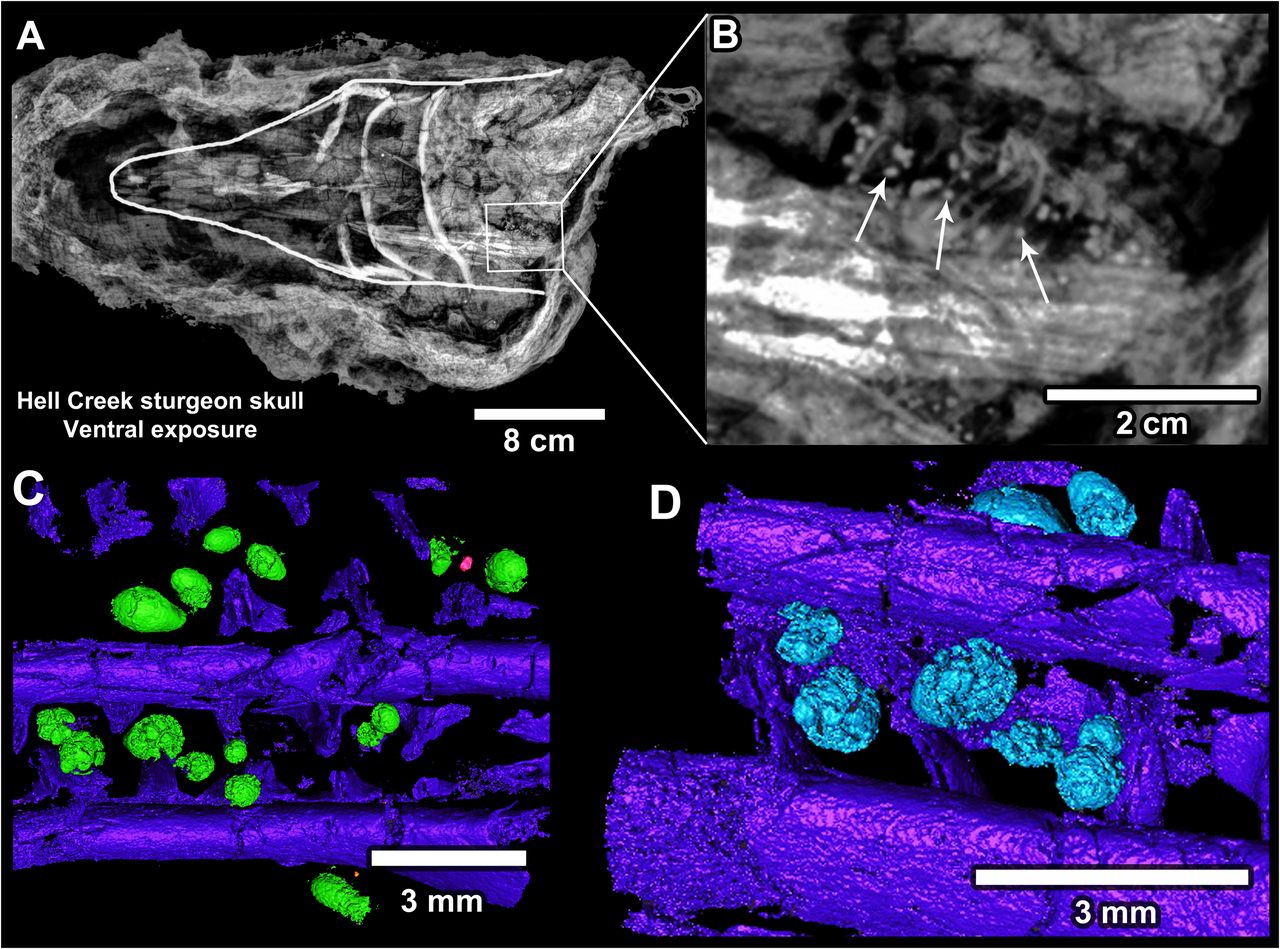
Credit: NASA Goddard Space Flight Center, via Wikimedia Commons
Some paleontologists have recently put forth a controversial idea—that they’ve found a place where the time of year the dinosaurs died is captured precisely in the fossil record.
It’s called Tanis, in North Dakota. But it was once the northern end of an inland sea.
66 million years ago, when the Chicxulub asteroid struck the Yucatan Peninsula, it instantly wiped out all life within 1,000 miles. But Tanis is nearly 2,000 miles away—what happened here?
Glass spherules, made of quartz, rained down from the heated atmosphere.
Shock waves from the huge earthquake caused by the asteroid sloshed the inland sea, in waves up to 30 feet high.
Fish died with spherules caught in their gills. Schools of them were found preserved in rocks, with open mouths suggesting death by suffocation.
Their bony plates show they had just begun the rapid growth of spring but had not reached the maximum growth of summer.
Other animals and plants were buried upright, frozen in place, not flattened like typical fossils.
If the scientists are right, this pegs the asteroid impact to a spring day in the Northern Hemisphere, which would have made its animals and plants more vulnerable than those in the Southern Hemisphere, where they could have already begun winter hibernation.
More fascinating clues in our quest to understand the event that made way for mammals, like us, to inhabit the Earth.
Background
Synopsis: When the Chicxulub impactor crashed into shallow seas covering Mexico’s Yucatan Peninsula, it took 10 hours for tsunami waves to reach the Mississippi Embayment. However, a remarkable fossil site in southwestern North Dakota shows that much faster seismic waves caused inland seas to slosh as much as 30 ft (10 m) above their banks within an hour of the impact, burying and preserving an entire ecosystem in the midst of spring growth and pollination. Glassy spherules, shocked quartz and fine iridium-laced dust punctuate the fossil record leading to an unprecedented timeline of the extreme events of the final spring day of the Mesozoic Era in North America. Geological forensics in action!
- Sixty-six million years ago, the 7.5 mi (12 km) Chicxulub impactor crashed into ancient shallow seas that covered today’s Yucatan Peninsula, with 10 billion times the power of the Hiroshima nuclear bomb. See more details in ED-096 Real-World Apocalypse.
- Although it was only about half as wide as Manhattan is long, the stony meteorite left a crater 12 mi (19 km) deep and 93 mi (150 km) in diameter.
- The impact generated energy equivalent to a magnitude 10 or 11 earthquake that would have been felt globally.
- Scientists have estimated that it took tsunami waves 10 hours to reach the Mississippi Embayment where they rushed up to 100 km beyond the Cretaceous coastline into Arkansas and Missouri.
- At the time of the impact, the Gulf of Mexico extended northward into a broad inland sea known as the Western Interior Seaway that stretched from Texas to Wyoming, Montana and the Dakotas.
- Ten million years earlier it had extended all the way to the Arctic Ocean but was progressively filling with sediments eroded from mountains to the west.
- In 2008, scientists discovered a remarkably well-preserved end-Cretaceous fossil site near the northern end of the Seaway in southwestern North Dakota’s Hell Creek Formation, naming it Tanis.
- After a decade of excavation and study, they began to share their results.

Diagram depicting the currently named Dinosauria (avians excluded) from the Late Cretaceous Hell Creek Formation in the United States. These species became extinct after the Chicxulub impact.
Credit: PaleoNeolitic, via Wikimedia Commons
- After a decade of excavation and study, they began to share their results.
- In ED-080 High-Impact Mystery, we described the discovery of an iridium-rich clay layer identified globally at the boundary between the Cretaceous and the Paleogene Systems. Since iridium is rare on Earth, but plentiful in meteorites, this layer represents far-reaching airfall dust from the Chicxulub impactor.
- Where it was discovered near Gubbio, Italy, this boundary clay layer is just 1/2 in (1 cm) thick.
- In North Dakota, it is usually about twice that thickness and is characterized by a distinctive pair of peach-colored layers: the lower two-thirds includes ejecta spherules while the upper third contains shocked minerals and finer-grained sediments enriched in iridium and other platinum group elements.
- However, at Tanis, the impact deposit is 51 in (130 cm) thick, containing ejecta throughout with an iridium-rich capping layer. The deposit provides a detailed record of events that occurred on that fateful day in a large meandering freshwater river not too far from its connection to the Western Interior Seaway.

Overview of the location of Tanis and how the site is laid out.
Credit: Figures are in a published paper by Robert dePalma and others. The individual authors responsible for each specific image or diagram in the paper are not individually stated., via Wikimedia Commons
- Scientists have calculated the incredibly short travel time required for the arrival at Tanis of various impact-related effects from the impact site about 1,895 mi (3,050 km) away.
- P, S and Rayleigh seismic waves would have arrived at 6, 10 and 13 minutes after impact.
- Ballistics calculations show that glassy ejecta spherules would have reached the atmosphere above Tanis just 13 to 25 minutes after the impact.
- Ballistics also say that shocked quartz would have rained down on the riverbank from about 38 to 120 minutes after the distant impact.
- About 3/4 in (2 cm) of these shocked minerals and fine-grained airfall material including iridium dust sealed within hours of the initial Chicxulub impact.
- The fossils in the impact deposit make it clear that there was total mayhem in the river soon after ejecta began to arrive.

This fossil fish from Tanis shows microtektites (molten splattered glass droplets) that are a chemical match for ejecta from the Chicxulub asteroid crater.The microtektites are concentrated in large numbers in the gill rakers of approximately 50% of the sturgeon and paddlefish fossils and show that the fish were alive when the impact occurred.
Credit: Figures are in a published paper by Robert dePalma and others. The individual authors responsible for each specific image or diagram in the paper are not individually stated., via Wikimedia Commons- Freshwater sturgeon and paddlefish that breathe and feed by sucking water in through their gills died with spherules caught in their gills—they were alive to inhale the spherules but died before the spherules entered their stomachs.
- Fossil fish in the impact deposit were found oriented parallel to each other and parallel to the riverbank, with open mouths indicating death by suffocation.
- This orientation and other sedimentary features indicate burial by sediments deposited by a strong onshore current, then a reversal to offshore flow, and then a repeat of onshore and offshore flow below the capping iridium-rich clay layer.
- Animals and plants were buried upright, not flattened like typical fossil death assemblages.
- Well preserved remains buried in the deposit include a turtle fatally impaled by a stick, fossils of hatchlings and intact eggs, fossil pterosaurs, and dinosaur parts.
- Marine ammonites were distributed among the freshwater fossils as violent waves ran up as much as 30 ft (10 m) over the riverbank setting.
- Some spherules made impact holes in the riverbank mud, while others were encased in tree resin and perfectly preserved from weathering in amber. Some of these may contain fragments of the actual impactor, studies are underway.
- What caused the violent end of this riverbank ecosystem?
- Scientists estimate that tsunami waves would have taken 18 to 26 hours to reach the northern end of the Cretaceous Western Interior Seaway, but that would have been long after the iridium dust had settled from the atmosphere to form the clay layer that caps the roiled-up sediments. So something else must have caused the fierce agitation of the river.
- Scientists believe the seismic S waves that arrived about 10 minutes after the impact set up seiches, huge surges of water that sloshed back and forth in the northern end of the Western Interior Seaway.
- As an analog, Japan’s 2011 Tohoku earthquake had a magnitude of about 9.2 that caused 5 ft (1.5 m) seiches (standing waves) in Norwegian fjords nearly 5,000 mi (8,000 km) away. Magnitude 10 to 11 ground motion may have been at least 30 times more intense and would have had the power to induce seiche waves of 30 ft (10 m) or more in the inland Seaway.
- Scientists have also worked out that the impact occurred during the faunal and floral productivity of the Northern Hemisphere’s spring season.
- Fossilized fish exhibited clear growth patterns in their bones, some with seven years of growth bands before the event. The last year of growth shows they had started the rapid growth of spring but had not reached the maximum growth rates typical of mid-summer.
- In nearby Wyoming, studies in the 1990’s established a death assemblage of water lily fossils in ponds with some varieties having produced seeds while others were still blooming and died before producing seeds.
- The active growth and pollination patterns exhibited in the riverbank and pond settings capped by the iridium layer are strong evidence for a spring impact in the Northern Hemisphere.
- A spring impact would have made Northern Hemisphere flora and fauna more vulnerable to the effects of the impactor, while Southern Hemisphere species hibernating in autumn may have been somewhat protected.

